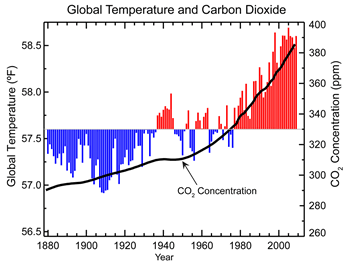Worldwide Climate Change
 World-wide climate change, the warming of the earth over a long period of time, is clearly documented to be accelerating and man-made, according to the Fifth Climate Assessment Report published in 2013 by the International Panel on Climate Change (a scientific intergovernmental body working under the auspices of the United Nations)
World-wide climate change, the warming of the earth over a long period of time, is clearly documented to be accelerating and man-made, according to the Fifth Climate Assessment Report published in 2013 by the International Panel on Climate Change (a scientific intergovernmental body working under the auspices of the United Nations)
Temperatures at Earth’s surface, in the troposphere (the active weather layer extending up to about 5 to 10 miles above the ground), and in the oceans have all increased over recent decades. The largest increases in temperature are occurring closer to the poles, especially in the Arctic. This warming has triggered many other changes to the Earth’s climate. Snow and ice cover have decreased in most areas. Atmospheric water vapor is increasing in the lower atmosphere because a warmer atmosphere can hold more water. Sea level is increasing because water expands as it warms and because melting ice on land adds water to the oceans. Changes in other climate-relevant indicators such as growing season length have been observed in many areas. Worldwide, the observed changes in average conditions have been accompanied by increasing trends in extremes of heat and heavy precipitation events, and decreases in extreme cold. It is the sum total of these indicators that leads to the conclusion that warming of our planet is unequivocal.
Climate Change in the Northeast
-
Massachusetts is set to experience a 5° to 10°F increase in average ambient temperature. Days with temperatures greater than 90°F are predicted to increase from the current 5 to 20 days annually to between 30 to 60 days annually. Up to 28 days annually are predicted to reach above 100°F compared to up to 2 days annually today. The higher incidence of extreme heat days, will have a negative impact on air quality and human health.
-
Sea surface temperatures are predicted to increase by 8°F.
-
Winter precipitation—mostly in the form of rain—is expected to increase by 12 to 30 percent.
-
Sea level rise, resulting from the fact that land in Massachusetts is naturally subsiding along with the projected thermal expansion of the oceans, the melting of ice on land (such as Greenland) and the collapse of the West Antarctic Ice Sheet, could reach six feet. Since a large percentage of the state‘s population, development, and infrastructure is located along the coast, the impact of this change will be significant, putting the Massachusetts economy, health, natural resources, and way of life at risk.
-
Floods from high intensity precipitation events are predicted to occur with greater intensity and frequency, resulting in severe and cumulative damage that strain local and state resources and the ability of government agencies to adequately respond.
Climate Change Adaptation on Martha's Vineyard
Martha's Vineyard can join other communities in the country and around the world to limit the acceleration of climate change by reducing the use of fossil fuels that produce greenhouse gases (as discussed in the Energy section of this website). However, we are too small to have a significant impact on the course of worldwide global warming, which now appears to be inevitable. The likely consequences of dramatic climate change on the Vineyard are so great that, although there is some uncertainty about the amount and rate, it would be wise to exercise caution by preparing to adapt to significant climate change. That is why the MVC’s efforts and this section of the website are focused on climate change adaptation.
-
Vulnerability Assessment: identifying vulnerable properties, roads, and habitats.
-
Strategies for Resiliency: public officials, businesses, and individuals identifying and selecting sensible measures to reduce future losses and plan for sensible development, infrastructure, and open space.
Websites
- IPCC: shows the most recent work that is being done on climate change world-wide.
- National Climate Assessment: a national report on how climate change is affecting the United States.
- Climate Change in New England: this section of the New England Aquarium website discusses the effects of climate change on New England.
- Climate Change – Commonwealth of Massachusetts: shows the effects climate change is projected to have on Massachusetts.
- VCS Climate Change Resources: The Vineyard Conservation Society’s website includes links to a number of reports about climate change and Martha's Vineyard including: Emissions Scenarios and Global Climate Change, Sea Level Rise, and Human Health Impacts.
Documents
- IPCC Fifth Climate Assessment Report - Summary for Policymakers (2013): a summary of the fifth international assemblage of IPCC.
- National Climate Assessment: the national Climate Assessment presented by the U.S. Global Change Research Program.
- National Climate Assessment Overview: an overview of the national Climate Assessment presented by the U.S. Global Change Research Program.
- National Climate Assessment Northeast: the Northeast section of the national Climate Assessment presented by the U.S. Global Change Research Program.
- Massachusetts Climate Change Adaptation Report (2011): Climate change report written for the Commonwealth of Massachusetts.
News Articles
-
2014 was the Warmest Year On Record: Summary of presentation by NASA and NOAA.

